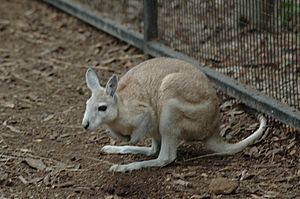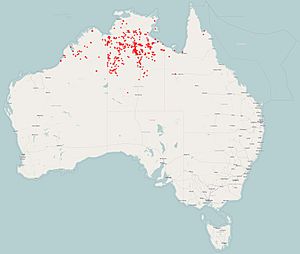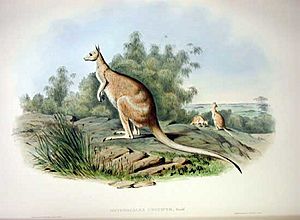Northern nail-tail wallaby facts for kids
Quick facts for kids Northern nail-tail wallaby |
|
|---|---|
 |
|
| Conservation status | |
| Scientific classification | |
 |
|
| The distribution of the northern nail-tail wallaby Data from The Atlas of Living Australia |
The northern or sandy nail-tail wallaby (Onychogalea unguifera) is a type of macropod. Macropods are a group of animals that includes kangaroos, wallabies, and quokkas. You can find this wallaby across northern Australia in dry, open areas with scattered trees.
This wallaby is the biggest of the Onychogalea group. It lives alone and is active at night. It eats plants, choosing from many different grasses and juicy plants. These wallabies look a bit like smaller kangaroos. They are usually about half a metre tall and weigh less than nine kilograms.
Like some larger kangaroos, they can move in a special "five-legged" way when they walk slowly. They use all four legs and their strong tail to help them move forward. When they need to escape quickly, they hop fast with their tail curled back. They also make a "wuluhwuluh" sound.
A cool thing about them is their super long tail. It has a broad, fingernail-like bump under a dark tuft of hair at the end. This is why they are called "nail-tail" wallabies! The name unguifera means "claw," referring to this unique feature. We don't know exactly why they have this special tail tip.
During the day, they rest in a shallow dip in the ground. If something disturbs them, they quickly run to hide in a hollow tree or thick bush. Unlike the rare bridled nail-tail wallaby, the northern nail-tail wallaby is not in danger of extinction. Sadly, another type, the crescent nail-tail wallaby, likely died out in the mid-1900s.
Contents
About Their Name
The first time the northern nail-tail wallaby was officially described was in 1840 by John Gould. He was a famous English ornithologist and artist. He gave it the name Onychogalea unguifera. The word unguifera comes from Latin and means "claw," which points to the unique nail-like tip on its tail.
Gould included pictures of these wallabies in his book The Mammals of Australia. The pictures were drawn by an artist named Henry C. Richter. The first wallaby studied by Gould was found by Benjamin Bynoe during the famous voyage of The Beagle along Australia's northwest coast.
Local Aboriginal people have different names for this wallaby. In the Walpiri language, it's called kururrungu. In the Dalabon language, it's called wuluhwuluh. This name comes from the sound the wallaby makes when it hops. It's one of the few animals named after its call! Some people also call it the "left-hand kangaroo."
There are two main types, or subspecies, of the northern nail-tail wallaby:
- Onychogalea unguifera unguifera: Found in the northwestern part of its home range.
- Onychogalea unguifera annulicauda: First described in 1884 from a young female found near the Norman River.
What They Look Like
The northern nail-tail wallaby is the largest of the Onychogalea group. All wallabies in this group have similar front teeth and that special dark, nail-like growth on their tail. This "tail nail" is very unusual for any mammal, and it's most noticeable on this species. Some people wonder if the tail nail is used for defence, like a weapon, or if it's a leftover from something their ancestors used to do.
These wallabies look light and graceful, similar to larger kangaroos. They are taller and heavier than other nail-tail wallabies, but their limbs and tail are longer in proportion to their body. When they hop, their arms are held stiffly and move in circles. They flee with their heads low and their long tail curled high, almost forming a half-circle.
Their head and body together are about 50 to 70 centimetres long. Their tail is even longer, measuring 60 to 74 centimetres, with an average length of 65 centimetres. When standing, they are about 0.65 metres tall. They weigh between five and nine kilograms.
Their fur is a sandy colour with reddish-brown tones, becoming lighter on their head and neck. Their sides are reddish, fading to a creamy white on their belly. A creamy stripe runs along their hip. The unique tail nail is hidden under a blackish tuft of hair, which covers the last third of their tail. The fur at the base of their tail is creamy white, sometimes blending into grey bands in the middle of the tail. Their ears are long, about 8 to 9.2 centimetres, mobile, and pale grey.
When they run away, they make a guttural "u-u-u" sound, which is where their Dalabon name "wuluhwuluh" comes from.
How They Live
This wallaby is a nocturnal animal, meaning it's active at night. It usually lives alone. It's a grazer and a forager, carefully choosing the tastiest grasses, herbs, and juicy plants. They are also known to eat some fruits.
During the day, they rest in shallow dips they scrape into the sand, often under trees or shrubs. They might try to hide under low bushes or in tall grass to avoid being seen.
When they walk slowly, the northern nail-tail wallaby uses a special "five-legged" movement. This means they use all four legs and their strong tail to push themselves forward. This unique way of moving has been seen in other macropods, and videos confirm that this species definitely uses its tail in this way.
One northern nail-tail wallaby was even kept as a pet in a garden in Victoria in the early 1900s! It was friendly when it was active and recognized the person who cared for it.
Where They Live
The northern nail-tail wallaby lives only in northern Australia. It likes many different dry habitats and can be common in some places. You can find them in the northern parts of the continent, usually away from the coast. Their range stretches from the Cape York Peninsula in the east, through the Top End, and across the Kimberley region to the northwest coast. They are found in patches within this large area, but their numbers haven't changed much since the late 1900s.
They often live in areas with tough, clumpy grasses or low shrubs, mixed with a few trees in dry landscapes. They especially like places where clay soils meet sandy soils. They have also been seen in thick stands of Melaleuca trees.
In 2015, experts decided that the northern nail-tail wallaby is of "least concern" for conservation. This means their population is thought to be large, they live in many areas including protected reserves, and their numbers are not dropping quickly enough to threaten them with extinction. However, their favourite habitats are not always found in protected areas, which could make them vulnerable to changes in land use and bushfires.
The red fox (Vulpes vulpes), which was brought to Australia by people, is a predator of these wallabies. Foxes are thought to have caused the wallabies to disappear from their southern habitats. As foxes spread north, they could become a threat to the wallabies there.
Studies with Aboriginal people in northern Australia, who know these animals well and hunt them for food, show that the wallaby population in Arnhem Land is stable, with only a small decline.
Native predators might include the freshwater crocodile (Crocodylus johnstoni). This smaller crocodile can eat wallabies that have died and might even catch them alive.
Fossils of the northern nail-tail wallaby have been found in Victoria, showing they once lived much further south. They were also found on the Montebello Islands, which are now underwater, suggesting they once lived in areas south of the Kimberley.
In 1924, some northern nail-tail wallabies were released at Wilsons Promontory in Victoria. This was an attempt to introduce them to the area, but it was not successful.
Images for kids
See also
 In Spanish: Canguro rabipelado del norte para niños
In Spanish: Canguro rabipelado del norte para niños





